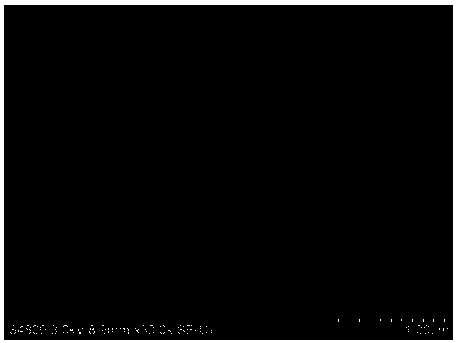Preparation method of 3D (three-dimensional) porous nitrogen-sulfur doped anode carbon material based on short rod construction
A three-dimensional porous, carbon material technology, applied in the preparation/purification of carbon, battery electrodes, structural parts, etc., to achieve the effect of simple experimental operation and low cost
- Summary
- Abstract
- Description
- Claims
- Application Information
AI Technical Summary
Problems solved by technology
Method used
Image
Examples
Embodiment 1
[0017] (1) Dissolve 40mg of graphene oxide in 10ml of deionized water, ultrasonically disperse, then add 126mg of melamine, stir evenly, and record it as liquid A.
[0018] (2) Dissolve thiocyanuric acid in 25ml of dimethyl sulfoxide to prepare a solution with a concentration of 7.08 mg / ml, which is recorded as solution B.
[0019] (3) Slowly pour liquid B into liquid A and stir at 60°C for 2 hours.
[0020] (4) The prepared sample was dried by vacuum drying method, and then heated to 550°C at a heating rate of 2°C / min under the protection of argon atmosphere and kept for 5h. That is, a three-dimensional porous nitrogen-sulfur-doped carbon material constructed by short rods is obtained.
Embodiment 2
[0022] (1) Dissolve 50mg of graphene oxide in 10ml of deionized water, ultrasonically disperse, then add 126mg of melamine, stir evenly, and record it as liquid A.
[0023] (2) Dissolve thiocyanic acid in 25ml of ethanol to prepare a solution with a concentration of 10.62 mg / ml, which is recorded as solution B.
[0024] (3) Slowly pour liquid B into liquid A and stir at 70°C for 5 hours.
[0025] (4) The prepared sample was dried by vacuum drying method, and then heated to 750°C at a heating rate of 5°C / min under the protection of argon atmosphere and kept for 1h. That is, a three-dimensional porous nitrogen-sulfur-doped carbon material constructed by short rods is obtained.
Embodiment 3
[0027] (1) Dissolve 80mg of graphene oxide in 20ml of deionized water, ultrasonically disperse, then add 63mg of melamine, stir evenly, and record it as liquid A.
[0028] (2) Dissolve thiocyanuric acid in 20ml of nitrogen-methylpyrrolidone to prepare a solution with a concentration of 14.16 mg / ml, which is recorded as solution B.
[0029] (3) Slowly pour liquid B into liquid A and stir at 70°C for 5 hours.
[0030] (4) The prepared samples were dried by freeze-drying, and then heated to 850°C at a heating rate of 10°C / min under the protection of an argon atmosphere and kept for 2 hours. That is, a three-dimensional porous nitrogen-sulfur-doped carbon material constructed by short rods is obtained.
[0031] Refer to attached figure 1 , figure 1 SEM photographs of samples prepared for this example. Using the S-4800 scanning electron microscope (SEM) of Japan Electronics Corporation to observe the morphology, it can be clearly seen that the three-dimensional porous nitrogen-...
PUM
 Login to View More
Login to View More Abstract
Description
Claims
Application Information
 Login to View More
Login to View More - R&D
- Intellectual Property
- Life Sciences
- Materials
- Tech Scout
- Unparalleled Data Quality
- Higher Quality Content
- 60% Fewer Hallucinations
Browse by: Latest US Patents, China's latest patents, Technical Efficacy Thesaurus, Application Domain, Technology Topic, Popular Technical Reports.
© 2025 PatSnap. All rights reserved.Legal|Privacy policy|Modern Slavery Act Transparency Statement|Sitemap|About US| Contact US: help@patsnap.com

